CIVIL TECHNOLOGY: WOODWORKING GRADE 12 MEMORANDUM - NSC EXAMS PAST PAPERS AND MEMOS NOVEMBER 2018
Share via Whatsapp Join our WhatsApp Group Join our Telegram GroupCIVIL TECHNOLOGY: WOODWORKING
GRADE 12
NSC EXAMS
PAST PAPERS AND MEMOS
NOVEMBER 2018
MEMORANDUM
QUESTION 1: OHSA, MATERIALS, TOOLS, EQUIPMENT AND JOINING (GENERIC)
1.1
1.1.1 F ✔ (1)
1.1.2 A ✔ (1)
1.1.3 G ✔ (1)
1.1.4 E ✔ (1)
1.1.5 B ✔ (1)
1.2
- Do not throw any tools or materials from a scaffold. ✔
- Never jump on to and off a scaffold. ✔
- Never overload a scaffold.
- Remove or cover sharp edges or corners.
- Always attach free-standing scaffoldings to a building.
- Use a ladder to get on and off a scaffold.
- Keep free of waste or any other obstruction.
- Never jump on a scaffold while working on it.
- Responsible/qualified person must ensure that scaffolding is safe, rigid, stable and firm or has no defects.
- Scaffold must be supplied with guard rails/toe boards.
- Scaffolds must be levelled on uneven ground.
- Do not work on a scaffold in bad weather.
- Wear a safety harness when working on scaffolding.
- Do not throw tools on/off a scaffold.
ANY TWO OF THE ABOVE (2)
1.3
- It prevents workers from falling off the scaffold. ✔
- It is used as a handrail. ✔
- It is used to strap on safety harnesses.
- To protect the worker working on the scaffold.
ANY TWO OF THE ABOVE (2)
1.4
- The primary purpose of painting is to protect metals, wood and other material against corrosion and decay. ✔
- Provides a decorative/aesthetic appearance/finishing. ✔
- Protects surfaces from moisture penetration.
- Protects surfaces from rust/uv rays.
ANY TWO OF THE ABOVE (2)
1.5 The curing of concrete:
- Increases the strength of concrete. ✔
- Decreases the permeability of hardened concrete.
- Improves durability of concrete by reducing cracks.
- Makes concrete more watertight.
- Minimises shrinkage cracks in concrete.
- Provides volume stability.
- Cured concrete can carry more weight without breaking/crumbling than uncured concrete.
- Prevents rapid drying of concrete.
- Curing ensures that the hydration process continues.
ANY ONE OF THE ABOVE (1)
1.6
1.6.1 Multi detector ✔ (1)
1.6.2 Tool A is used:
- to detect materials found in/behind walls, ceilings and underneath floors, including ferrous and non-ferrous metals, electrical wiring, wood and metal studs. ✔
- to locate steel bars and copper pipes. ✔
- in carpentry, plumbing, and construction.
- to measure the distance to/from covered objects.
ANY TWO OF THE ABOVE (2)
1.6.3 The batteries must be removed from the tool:
- to prevent the battery from running flat/battery can die. ✔
- to prevent acid leaks from batteries damaging the tool.
ANY ONE OF THE ABOVE (1)
1.7
1.7.1
A – Bolt and nut/Bolt ✔
B – Rawl bolt ✔ (2)
1.7.2 Bolt and nut
- Bolts and nuts are used to secure pipe supports to metal parts. ✔
- To join components together.
Rawl bolt
- A Rawl bolt is used to fix a truss hanger to a wall. ✔
- To fix brackets/structures/panels to a wall/concrete.
- For construction, renovation and industrial work
ANY TWO OF THE ABOVE (2) [20]
QUESTION 2: GRAPHICS AS METHOD OF COMMUNICATION (GENERIC)
ANSWER SHEET 2
NO. | QUESTIONS | ANSWERS | MARKS |
1 | Identify FIGURE A. | South Elevation/Elevation ✔ | 1 |
2 | Identify FIGURE B. | Ground floor plan/Floorplan ✔ | 1 |
3 | Identify number 4. | First floor level/Second floor level/Suspended floor/Floor level/ Dash line/ FFL/Expansion joint ✔ | 1 |
4 | Identify number 5. | Window Sill ✔ | 1 |
5 | Identify number 9. | Hand wash basin/Wash basin/Washing basin/HWB/Basin ✔ | 1 |
6 | Identify number 10. | Water closet/WC/Toilet pan ✔ | 1 |
7 | Identify number 11. | Bath/B ✔ | 1 |
8 | On what date was the plan printed? | 2018/10/02 ✔ | 1 |
9 | Who drew the building plan? | JP Maloi ✔ | 1 |
10 | Name the feature in the column for the notes in FIGURE 2 that must be installed in front of the sliding door. | Ramp ✔ | 1 |
11 | Name the feature in the column for the notes in FIGURE 2 that must give access to the first floor. | Staircase/Stairs/Stairway✔ | 1 |
12 | Identify the type of roof that is used for the building in FIGURE A. | Gable roof ✔ | 1 |
13 | Explain the purpose of number 1. | To cover the opening/close the gap between the two slopes of the roof. ✔ | 1 |
14 | Explain the purpose of number 2. |
| 1 |
15 | Explain the abbreviation FFL at number 6. | Finished floor level ✔ | 1 |
16 | Explain the purpose of number 7. | To channel the water from the gutter to the ground. ✔ | 1 |
17 | Explain the meaning of the arrow on the feature that must be installed in front of the sliding door. | It indicates the direction of the slope of the ramp/it indicates the slope. ✔ | 1 |
18 | Explain what is meant by 1:10 indicated on the symbol in the notes. | It indicates the slope or the gradient of the ramp/for every 10 metres horizontally rises 1 metre vertically.✔ | 1 |
19 | Which room will feature 15 serve? | The bathroom. ✔ | 1 |
20 | Explain the short dash lines on the windows. |
| 1 |
21 | Deduce the height of window 2 from the window schedule. | 1,2 m or 1 200 mm ✔(Ignore units) | 1 |
22 | Deduce the width of window 3 from the window schedule. | 2 m or 2 000 mm ✔(Ignore units) | 1 |
23 | On what elevation of the building is the bathroom window situated? | Western elevation/Western side ✔ | 1 |
24 | Differentiate between component number 3 and component number 8. | 3 – window/window frame/reveal frame stile/casement stile ✔ | 2 |
25 | Differentiate between the light in the lounge and the light in the bathroom. | The light in the lounge is a fluorescent light/1 x 40W-/2x40- /3x40 fluorescent light ✔ and the light in the bathroom is a normal ceiling light ✔ | 2 |
26 | Recommend a suitable floor covering for the bathroom. | Tile/ Vinyl flooring(Novilon)/ Coloured screed/Polished or stained concrete flooring/Water proof laminated floor/carpet. ✔ | 1 |
27 | Recommend an appropriate scale to which FIGURE A should be drawn, according to SANS. | 1:50/100/200 ✔ | 1 |
28 | Recommend an alternative sanitary fitment to replace number 11 that will serve a similar purpose. | Shower ✔ | 1 |
29 | Calculate the internal area of the office in m² Show ALL calculations. | 4 m ✔ x 3 m ✔ = 12 m² ✔ OR 12 | 3 |
30 | Calculate the perimeter of the building. Show ALL calculations. | Positive marking | 7 |
TOTAL | 40 |
QUESTION 3: CASEMENTS, CUPBOARDS, WALL-PANELLING AND QUANTITIES (SPECIFIC)
3.1
3.1.1 Tongue and groove boards ✔ (1)
3.1.2 520 mm - 570 mm ✔ (1)
3.1.3 Cornice ✔ (1)
3.1.4 Drip groove ✔ (1)
3.1.5 Fanlight ✔ (1)
3.2
3.2.1
- A – Wood/Timber ✔ (1)
- B – Glass/Perspex ✔ (1)
3.2.2 This part is holding the glass/pane in its place. ✔ (1)
3.3
3.3.1
- A Storage space/top unit ✔
- B Hanging space ✔
- C Shelves/storage space/shelf ✔
- D Drawers ✔ (4)
3.3.2 Melamine:
- is waterproof. ✔
- is easier to clean.
- is more durable.
- enhance inside appearance.
- has a smooth finish.
OR
Chipboard:
- Is not water proof
- Is not easy to clean
- Is less durable
- Does not enhance the inner appearance
- Is not as smooth (1)
ANY ONE OF THE ABOVE
3.3.3
- E – Front rail/Top rail ✔
- F – Oval hanging rail/Hanging rail/Pipe rail ✔
- G – Side ✔
- H – Kick plate/base/Bottom rail/Plinth ✔ (4)
3.4
3.4.1
- A – Cornice ✔
- B – Horizontal rough grounds ✔ (3)
- C – Quarter round/Quadrant ✔
3.4.2
- To enhance appearance. ✔
- To give an aesthetic appearance. ✔
- There is no need to plaster the wall where panelling is to be done.
- It serves as insulation against sound and heat.
- For durability
ANY TWO OF THE ABOVE(2)
3.5
A | B | C | D | ||
| 3.5.1 | Internal measurements of long walls: | ||||
= 9 000 – 2/220 = 8 560 mm ✔ | |||||
OR | |||||
= 9 000 - 440 = 8 560 mm | |||||
Length of wall plates needed: | (4) | ||||
| 3.5.2 | 2/✔ | 8,56 ✔ | 17,12 ✔ | 17,12 m wall plate needed | |
Number of purlins needed | |||||
Number of purlins = Length of rafter + 1 | |||||
= 3,6 ✔ + 1 OR 3 600 + 1 | |||||
= (4 + 1) ✔2 ✔OR (5x2) | |||||
= 10 purlins ✔ | (4) |
[30]
QUESTION 4: ROOFS, CEILINGS, TOOLS AND EQUIPMENT, AND MATERIALS (SPECIFIC)
4.1
4.1.1 C ✔ (1)
4.1.2 A ✔ (1)
4.1.3 D ✔ (1)
4.1.4 E ✔ (1)
4.1.5 F ✔ (1)
4.2
4.2.1
- A Hipped end ✔
- B Purlin ✔
- C Ridge/Ridge plate ✔
- D Valley rafter/Valley ✔
- E Overhang/Eaves overhang ✔
- F Gable end/Gable wall/Wall/Side of building ✔ (6)
4.2.2
- 76 mm x 50 mm ✔
- 76 mm x 76 mm
ANY ONE OF THE ABOVE (1)
4.3
- It allows rain water to be directed into the gutter. ✔
- So that water does not damage the end of the rafters. (1)
ANY TWO OF THE ABOVE
4.4
- A good roof covering must be able to resist weather conditions such as rain and wind/resistance against corrosion. ✔
- Should look durable and enhances the appearance of the building. ✔
- Should be fire resistant.
- Should provide insulation against heat and cold.
ANY TWO OF THE ABOVE (2)
4.5  (4)
(4)
4.6
- The installation of steel roofing is faster. ✔
- The installation of steel roofing is more economical. ✔
- The installation of steel roofing is simpler.
- Steel roof covering is cheaper than tiles.
- Steel roof covering is environment friendly.
ANY TWO OF THE ABOVE (2)
4.7
- If roof underlay is not installed there will be more dust inside the roof space. ✔
- If roof underlay is not installed, the roof may not be fully waterproof. ✔
- The risk of wind lifting tiles becomes greater.
- Insulating would not be good.
ANY TWO OF THE ABOVE (2)
4.8
- A - Tie beam ✔
- B - Brandering ✔
- C - Trapdoor ✔
- D - Cover strip ✔ (4)
4.9.1
- A – Router ✔
- B – Combination belt and disc sander. ✔ (2)
4.9.2
- Store in a safe, dry place. ✔
- Store it in a wooden or plastic box away from moisture. ✔ (2)
4.9.3
- Maintain like all machinery – lubricate and adjust according to the manufacturer’s instructions. ✔
- Clean the belt/disc sander after use. ✔
- Repair or replace damaged electrical cords.
- Handle the sander so as not to damage or impair its accuracy.
- Use machinery only for the intended purpose.
- Do not force material onto the belt/disc of the sander.
- Avoid the use of worn out (clogged) belts and discs.
- ervice the machine regularly.
ANY TWO OF THE ABOVE (2)
4.9.4
- Table saw/Circular saw/Mitre saw ✔
- Band saw ✔
- Radial arm saw ✔
- Jigsaw
- Scroll saw
ANY THREE OF THE ABOVE (3)
4.10.1
- M – Mechanical grading ✔
- V – Visual grading ✔ (2)
4.10.2 6 - The number indicates the strength. ✔ (1)
4.10.3 The SABS symbol. ✔  (1)
(1)
[40]
QUESTION 5: CENTERING, FORMWORK, SHORING AND GRAPHICS AS MEANS OF COMMUNICATION (SPECIFIC)
5.1
- A - Concrete beam/Concrete ✔
- B - Brace/Strut ✔
- C - Prop/Adjustable prop ✔
- D - Sole plate ✔ (4)
5.2
- Block board ✔
- Laminated board ✔
- Shutter board ✔
- Plywood ✔
- Timber
- Hard board/Masonite
ANY FOUR OF THE ABOVE (4)
5.3
- Wedges are inserted under the bearers and props to support the formwork. ✔
- Wedges keep the different formwork components sturdy and fixed. ✔
- Wedges help with the lowering and raising of the formwork. ✔
- Wedges are used for the levelling of the formwork.
- Wedges ease the striking of formwork.
ANY THREE OF THE ABOVE (3)
5.4
- It supports more weight. ✔
- Support the weight of the fresh concrete.
ANY ONE OF THE ABOVE (1)
5.5
5.5.1
- A – Laggings ✔
- B – Ribs ✔
- C – Bearer ✔ (3)
5.5.2 Brick arches because they have a solid surface. ✔ (1)
5.5.3
- Openly spaced laggings/Open laggings/Open ✔
- Laggings are not close to each other. (1)
- There are spacing’s between the openings of the laggings.
ANY ONE OF THE ABOVE
5.6
5.6.1
- Dead shores are used to support structures. ✔
- Dead shores carry dead weight above the dead shores, e.g. walls, floors.
- Support existent walls if openings are made.
- Transfer the weight of the structure to firm ground during structural renovations.
- Support a wall if alterations are made.
ANY ONE OF THE ABOVE (1)
5.6.2
- Double flying shores provide temporary support to TWO parallel walls where one or two walls show signs of failure. ✔
- Double flying shores give temporary support to TWO parallel defective walls.
- Double flying shores can only be used with TWO parallel defective walls between 9 and 15 meters.
ANY ONE OF THE ABOVE (1)
5.7
5.7.1 The steel dog is used to secure the joint between prop and needle. ✔ (1)
5.7.2 Props are used to strengthen or brace the floors and ceiling. ✔ (1)
5.7.3
- Sole plates spread the weight transferred by the props over a wider area.✔
- Prevent vertical props/pipes from sinking into the ground.
- The soleplate create a level area where the props rest on. (1)
5.8 45° ✔ (1)
5.9 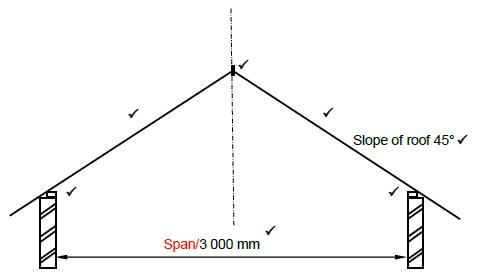 (7)
(7)
ASSESSMENT CRITERIA | MARK | CANDIDATE'S MARK |
Span | 1 | |
Wall plates | 2 | |
Rafters | 2 | |
Ridge beam | 1 | |
Slope of the roof 45° | 1 | |
TOTAL: | 7 |
[30]
QUESTION 6: SUSPENDED FLOORS, STAIRCASES, IRONMONGERY, DOORS AND JOINING (SPECIFIC)
6.1
6.1.1 D ✔ (1)
6.1.2 C ✔ (1)
6.1.3 B ✔ (1)
6.1.4 A ✔ (1)
6.1.5 A ✔ (1)
6.2 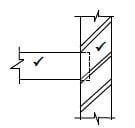
Joist built into wall
ASSESSMENT CRITERIA | MARK | CANDIDATE'S MARK |
Joist | 1 | |
Built into wall | 1 | |
TOTAL | 2 |
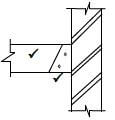
Joist secured to wall with truss/joist hanger (4)
ASSESSMENT CRITERIA | MARK | CANDIDATE'S MARK |
Joist | 1 | |
Truss/Joist hanger | 1 | |
TOTAL: | 2 |
6.3 Alternative drawing will also be acceptable 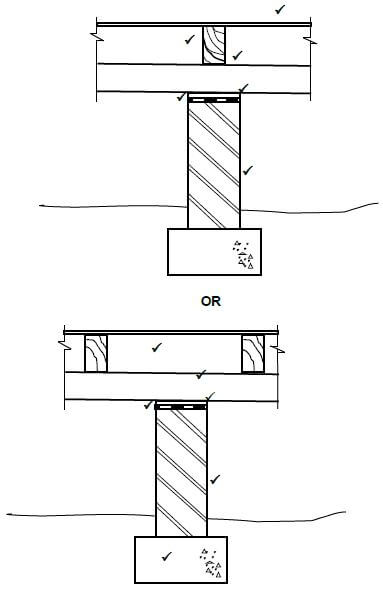 (6)
(6)
ASSESSMENT CRITERIA | MARK | CANDIDATE'S MARK |
ONE one-brick pier | 1 | |
DPC/Proportion | 1 | |
Ant guard | 1 | |
Bearer | 1 | |
Joist | 1 | |
Floor boards | 1 | |
TOTAL | 6 |
6.4 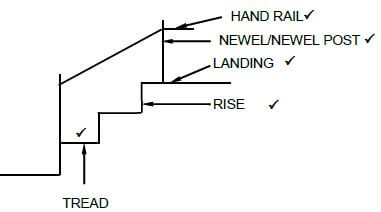 (5)
(5)
2 OR 3 DIMENSIONAL DRAWINGS WILL BE ACCEPTED
6.5
- Serves as a place of rest. ✔
- For safety in case of a falling accident.
- Facilitates a change in direction when moving up or down stairs.
ANY ONE OF THE ABOVE (1)
6.6
6.6.1 Door stile/Lock rail ✔ (1)
6.6.2 Frame stile/Door frame/Stile ✔ (1)
6.6.3 Frame stile/Door frame/Stile ✔ (1)
6.6.4 Door stile ✔ (1)
6.7
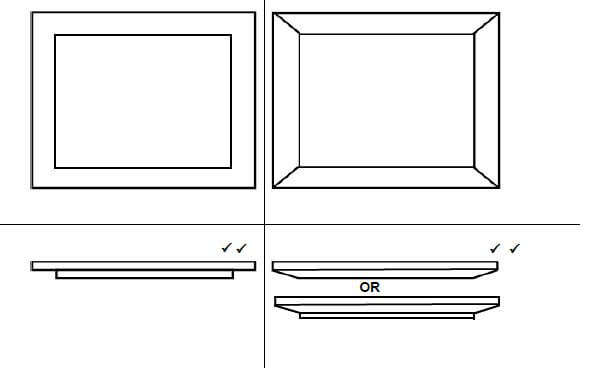 (4)
(4)
ASSESSMENT CRITERIA | MARK | CANDIDATE'S MARK |
Raised panel top view | 2 | |
Raised and fielded panel top view | 2 | |
TOTAL | 4 |
6.8 The opening allows shrinkage ✔ and expansion of the panel/wood. (1)
6.9
- A – Brace/Strut ✔
- B – Tongue and groove battens/V- Tongue and groove battens ✔
- C – Stile ✔ (3)
6.10
6.10.1 Hinge (Any hinge accepted) ✔ (1)
6.10.2 Clout nail/Chipboard screws/Drywall screw ✔ (1)
6.10.3 Nail/Skew nail/Perm fix nail ✔ (1)
6.10.4 Gang nail/Bolt and nut/Nails ✔ (1)
6.11
- Hinges ✔
- Casement fasteners ✔
- Casement stays
ANY TWO OF THE ABOVE (2) [40]
TOTAL: 200